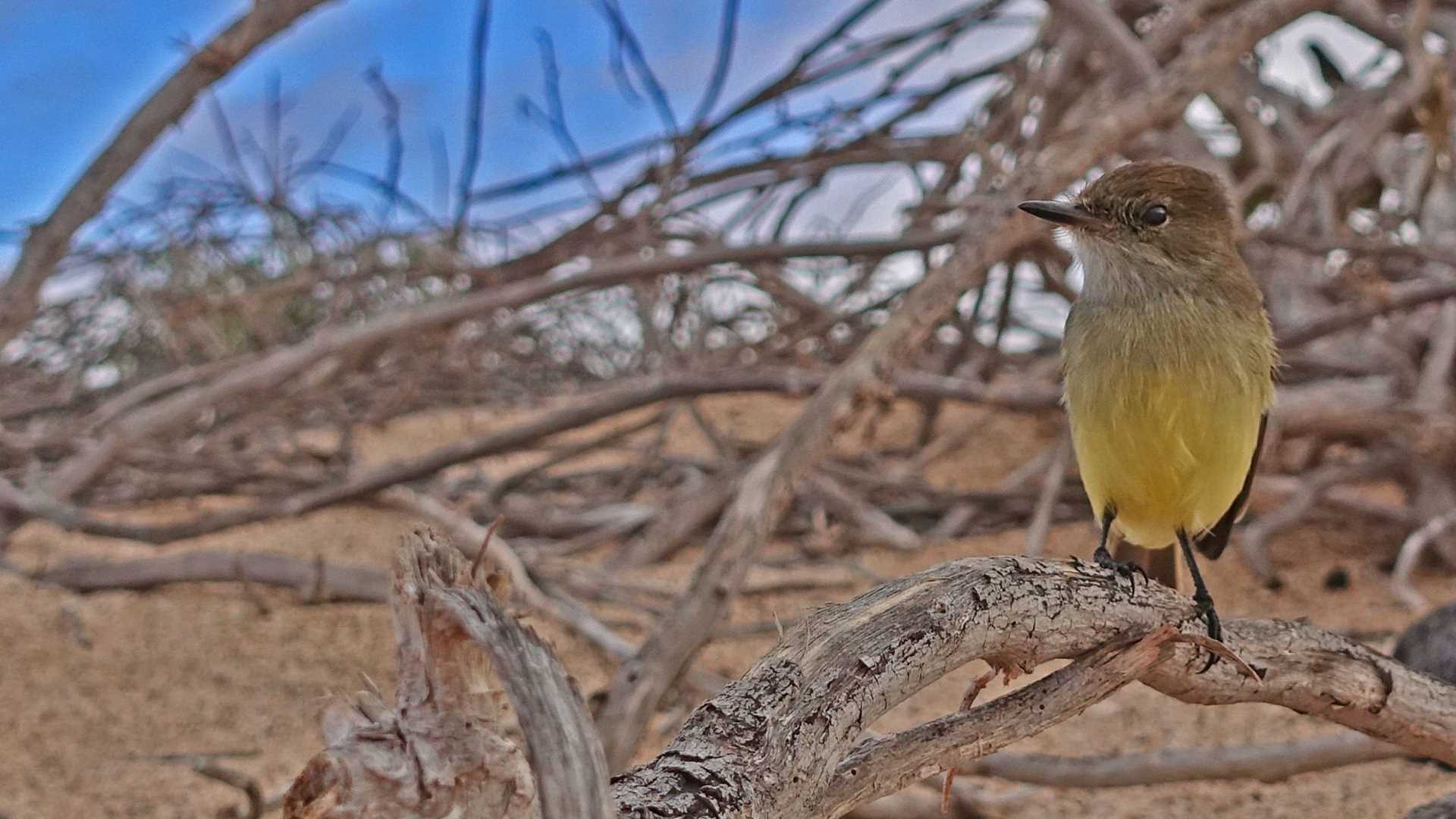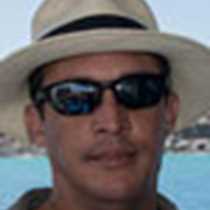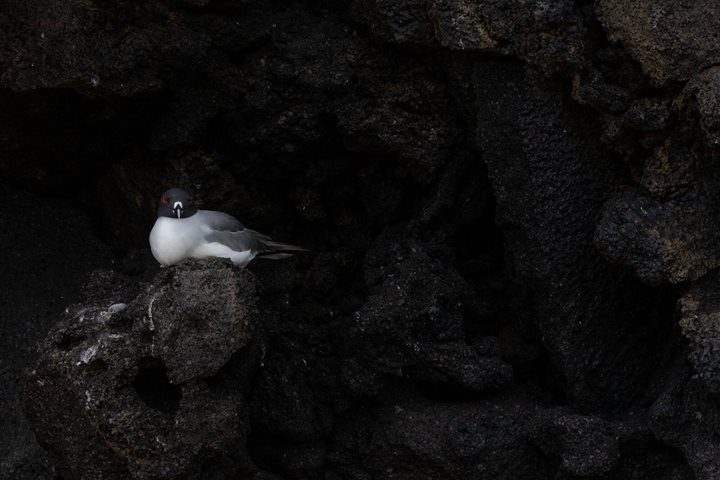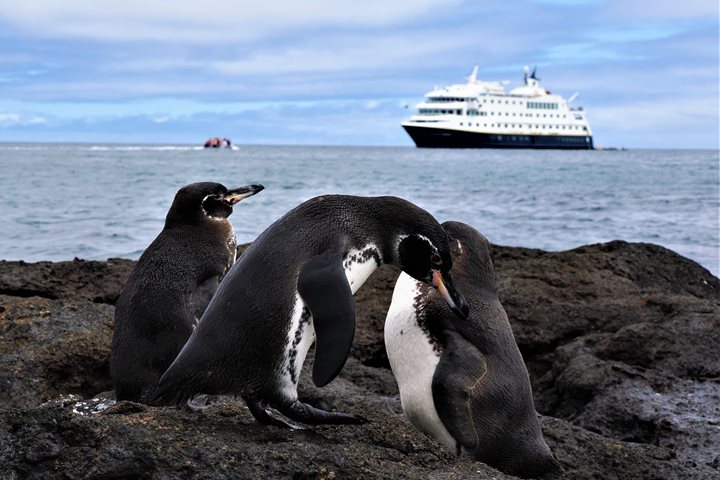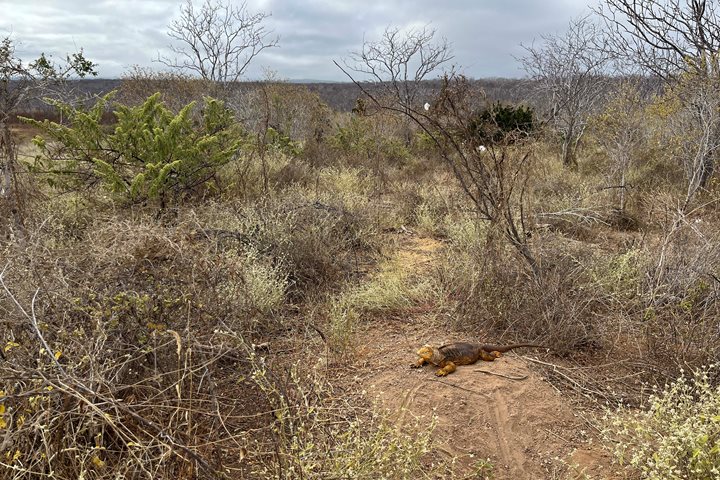Matted sunlight pokes through the clouds as we awaken at our anchorage between Baltra and North Seymour Islands. As we land on this unassuming flat island, we do not expect the abundance of life that we encounter. Due to the central position in the archipelago this island and surrounding waters has an abundance of food for the residents a good percentage of the year. This is one of the few places we can encounter the magnificent and great frigate birds breeding throughout the year with the males using their inflated gular sacs to attract possible mates. As we land we are greeted by land iguanas, frigate birds, marine iguanas, blue-footed boobies, and small lava lizards fliting about. All were taken aback by the abundance of life on this small barren island. Navigating into the afternoon, we arrive to Rabida, which in its dark red coloration we find another unique environment. The marine habitat is explored in all its detail with white tipped reef sharks, Pacific green sea turtles, and Galapagos sea lions making their appearance. The sun continues to try to break the overcast as it falls into the horizon over Isabela Island.
- Daily Expedition Reports
- 09 Jul 2017
North Seymour & Rabida Islands, 7/9/2017, National Geographic Endeavour II
- Aboard the National Geographic Endeavour II
- Galápagos
Jose Aguirre, Naturalist
José Enrique (Kike) was born in Quito, Ecuador. He moved to Israel in 1998 where he volunteered on a kibbutz for almost a year. During his time there he worked across various plantations, which inspired him to study agricultural engineering at the Po...
Read MoreShare Report
Galápagos Aboard National Geographic Endeavour II
VIEW ITINERARYRelated Reports
10/6/2022
Read
National Geographic Endeavour II
Bartolome Island & Sombrero Chino
On National Geographic Endeavour II today, we explored Bartolome, home of a small colony of Galapagos penguins. Bartolome is one of the youngest islands, and it is located next to Santiago Island in the central part of the archipelago. After an amazing sunrise, we went ashore for a walk, and we were transported back to a time when the land was newly formed. We began our day by hiking to the top of a tuff cone known as the islet of Bartolome, named after the First Officer of The Beagle . Walking on this young island allowed us to understand the formation and volcanism of the Galapagos Islands. The rocks are a great way to understand the area and its geology. We spotted a few lava lizards and painted locusts, some of the very few animals on this island. As we reached the top, we had a great view. Our guests enjoyed the magnificence of Pinnacle Rock. After we visited one of the most iconic geological formations of the Galapagos, our breakfast was enhanced by dramatic views of the impressive volcanic landscape. We visited the beach near Pinnacle Rock, where we enjoyed how the sun made the sand sparkle due to a concentration of silica. Later, we went snorkeling along the channel between Santiago and Bartolome Islands. Many of our guests spotted whitetip reef sharks and very colorful parrotfish. The landscape was beautiful with lots of sea stars. We enjoyed the chance to be surrounded by Galapagos penguins and feel accepted as part of this environment. After a delicious Mexican lunch, we had lectures on the photography of reptiles and Darwin. Afterwards, we went to Chinese Hat Islet to snorkel from the Zodiacs. The area is home to a small colony of Galapagos penguins. In a sandy-bottomed, sheltered channel, our guests enjoyed swimming with whitetip reef sharks, rays, and many fish. It was a nice and sunny afternoon. After snorkeling, we had the chance to explore the unique, small volcano that formed an island in front of Santiago on a sunset Zodiac ride. After a spectacular day full of activities in the field, we returned on board. Every day in the Galapagos is an opportunity to reconnect with the beauty of nature through unbelievable encounters!
10/5/2022
Read
National Geographic Endeavour II
Cerro Dragón, Santa Cruz Island
Today, National Geographic Endeavour II visited Cerro Dragon, located on the north part of Santa Cruz Island. We found one of the largest colonies of land iguanas. During our hike, we spotted the iguanas all around the trail. Some basked on the vegetation, and others were active. We saw the zigzag head movement they use to protect their territory and impress females. An Ecuadorian buffet lunch was set up in the dining room. We started with the traditional ceviche and ended with tres leches for dessert! We enjoyed snorkeling and Zodiac rides. We observed wildlife all over the place, including spotted eagle rays, sharks, blue-footed boobies, great blue herons, marine iguanas, and hundreds of other animals. They all reminded us why the Galapagos is so special.

